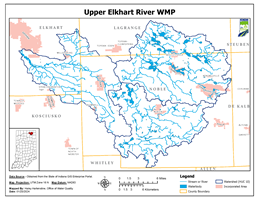Summary
The Elkhart River Watershed occupies portions of Elkhart, LaGrange, Noble, and Kosciusko counties. The headwaters begin with the North Branch of the Elkhart River in south-central LaGrange County and the South Branch of the Elkhart River in central Noble County. The Elkhart River then flows northwest into Elkhart County, forming the Goshen Dam Pond in Goshen, and finally draining into the St. Joseph River in the City of Elkhart.
The Watershed is approximately 447,000 acres of mixed land-use consisting mainly of row crop agriculture and pasture. In recent years the Watershed has experienced rapid urban growth. Most of the growth is occurring in the Elkhart-Goshen area in Elkhart County. However, other areas in Noble and Kosciusko Counties are also experiencing growth, such as the area around Albion in Noble County.
The Elkhart River Alliance (ERA) was formed as a committee of the Elkhart River Restoration Association, Inc. (ERRA) to address concerns regarding sediment in the Goshen Dam Pond and pollution in the Elkhart River Watershed. With assistance from the Elkhart County Soil and Water Conservation District (SWCD), the ERRA obtained funding from an U.S. Environmental Protection Agency (U.S. EPA) 319 grant through the Indiana Department of Environmental Management (IDEM) for the development and implementation of a Watershed Management Plan (WMP) for the Elkhart River Watershed. A Steering Committee of ERA members was organized to work with the watershed coordinator to develop and implement the WMP.
The Elkhart River WMP is intended as a guide for the protection and enhancement of the environment and quality of the Elkhart River Watershed while balancing the different uses and demands of the community on this natural resource. These goals address items such as:
- education and outreach;
- reducing the amount of pollution and sediment entering the aquatic systems;
- increasing preservation, restoration, and protection of this vital system;
- increasing cooperation, coordination, and collaboration among all stakeholders in the watershed; and,
- building and maintaining a solid organization to look to the welfare of this important natural resource.

